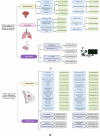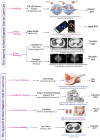The role of nanomedicine and artificial intelligence in cancer health care: individual applications and emerging integrations-a narrative review
- PMID: 40338421
- PMCID: PMC12061837
- DOI: 10.1007/s12672-025-02469-4
The role of nanomedicine and artificial intelligence in cancer health care: individual applications and emerging integrations-a narrative review
Abstract
Cancer remains one of the deadliest diseases globally, significantly impacting patients' quality of life. Addressing the rising incidence of cancer deaths necessitates innovative approaches such as nanomedicine and artificial intelligence (AI). The convergence of nanomedicine and AI represents a transformative frontier in cancer healthcare, promising unprecedented advancements in diagnosis, treatment, and patient management. This narrative review explores the distinct applications of nanomedicine and AI in oncology, alongside their synergistic potential. Nanomedicine leverages nanoparticles for targeted drug delivery, enhancing therapeutic efficacy while minimizing adverse effects. Concurrently, AI algorithms facilitate early cancer detection, personalized treatment planning, and predictive analytics, thereby optimizing clinical outcomes. Emerging integrations of these technologies could transform cancer care by facilitating precise, personalized, and adaptive treatment strategies. This review synthesizes current research, highlights innovative individual applications, and discusses the emerging integrations of nanomedicine and AI in oncology. The goal is to provide a comprehensive understanding of how these cutting-edge technologies can collaboratively improve cancer diagnosis, treatment, and patient prognosis.
Keywords: AI in healthcare; Artificial intelligence; Cancer; Digital healthcare; Drug delivery; Nanomedicine; Nanoparticles; Oncology.
© 2025. The Author(s).
Conflict of interest statement
Declarations. I hereby declare that this submission is entirely my own work, in my own words, and that all sources used in researching it are fully acknowledged and all quotations properly identified. Ethics approval and consent to participate: Not applicable. Consent for publication: All the authors have read and agreed to the final copy of the finding as contained in the manuscript. Competing interests: The authors declare no competing interests.
Figures







Similar articles
-
Smart nanomedicines powered by artificial intelligence: a breakthrough in lung cancer diagnosis and treatment.Med Oncol. 2025 Mar 25;42(5):134. doi: 10.1007/s12032-025-02680-x. Med Oncol. 2025. PMID: 40131617 Review.
-
Advancing the frontier of artificial intelligence on emerging technologies to redefine cancer diagnosis and care.Comput Biol Med. 2025 Jun;191:110178. doi: 10.1016/j.compbiomed.2025.110178. Epub 2025 Apr 13. Comput Biol Med. 2025. PMID: 40228444 Review.
-
Artificial Intelligence, the Digital Surgeon: Unravelling Its Emerging Footprint in Healthcare - The Narrative Review.J Multidiscip Healthc. 2024 Aug 15;17:4011-4022. doi: 10.2147/JMDH.S482757. eCollection 2024. J Multidiscip Healthc. 2024. PMID: 39165254 Free PMC article. Review.
-
Artificial Intelligence Advancements in Oncology: A Review of Current Trends and Future Directions.Biomedicines. 2025 Apr 13;13(4):951. doi: 10.3390/biomedicines13040951. Biomedicines. 2025. PMID: 40299653 Free PMC article. Review.
-
Application of artificial intelligence in cancer diagnosis and tumor nanomedicine.Nanoscale. 2024 Aug 7;16(30):14213-14246. doi: 10.1039/d4nr01832j. Nanoscale. 2024. PMID: 39021117 Review.
Cited by
-
Nanoparticle technologies in precision oncology and personalized vaccine development: Challenges and advances.Int J Pharm X. 2025 Jul 5;10:100353. doi: 10.1016/j.ijpx.2025.100353. eCollection 2025 Dec. Int J Pharm X. 2025. PMID: 40688030 Free PMC article. Review.
-
Assessment of extensor hallucis brevis stiffness and microcirculation in diabetes: shear wave elastography and contrast-enhanced ultrasound.Front Endocrinol (Lausanne). 2025 Jul 23;16:1639270. doi: 10.3389/fendo.2025.1639270. eCollection 2025. Front Endocrinol (Lausanne). 2025. PMID: 40771279 Free PMC article.
References
-
- Chen W, Zhou S, Ge L, Wu W, Jiang X. Translatable high drug loading drug delivery systems based on biocompatible polymer nanocarriers. Biomacromol. 2018;19:1732–45. - PubMed
Publication types
LinkOut - more resources
Full Text Sources
